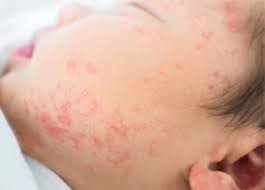It has been several months since the coronavirus pandemic began in our country and it seems that, for now, the virus is going to stay with us. Winter is near and the viruses typical of that time, including the flu, are beginning to arrive. But how do you distinguish what is a flu from COVID? Do your symptoms overlap?
COVID in children
The disease caused by the new Coronavirus is less studied in children because, for reasons that we do not yet fully know, it is much milder in them. But even so, we already have enough articles and experience to know that the symptoms that can appear are very varied and, as we have said, much milder.
Children rarely need hospital admission (in Spain those under 15 accounted for only 0.4% of admissions); even in some cases, children are asymptomatic. In this recent review, fever was found to be the most common symptom, appearing in almost 50% of the children studied, followed by cough.
Some children also had nasal congestion and / or upper respiratory tract infection (around 10%). Somewhat less frequent were diarrhea and nausea and vomiting. Fortunately, few had fatigue and shortness of breath. These findings are fairly consistent with those described in previous studies, where they also report that fever and cough were the most common symptoms, although there are cases of afebrile and even asymptomatic children.
Throughout these months it has also been seen that COVID can affect the skin. In this study of our country, a multitude of skin lesions (many indistinguishable from other diseases) compatible with COVID were collected.
The protocols created for going back to school vary slightly between communities but in general, the symptoms for which they should not go to school because they are compatible with COVID are multiple and varied: low-grade fever or fever, cough, nasal congestion, skin spots, headache, decreased taste or smell, muscle pain, chest pain, abdominal pain, diarrhea, vomiting, or patches on the skin. Come on, almost anything can be COVID. And let's not forget also that there is a certain percentage of children who are asymptomatic.
And although the majority of cases in children are mild, some serious cases of a systemic inflammatory syndrome have been described that resembles Kawasaki disease and Toxic Shock Syndrome and which has been called Pediatric Multisystemic Inflammatory Syndrome linked to SARS- CoV-2.
There are also some risk groups in which COVID can be more serious: immunosuppressed, transplanted, severe heart disease, children on dialysis, chronic and severe respiratory disease (for example children who require oxygen, with tracheostomy or mechanical ventilation at home), children undergoing chemotherapy ...
Flu in children
The flu is a viral infection, caused by the Influenza virus, a different virus from the coronavirus. It is seasonal, it usually appears in the cold months (from October to March). It is transmitted through aerosol particles and also directly through respiratory secretions.
The symptoms of the flu are very varied. Typically, a high fever, cough and mucus, chills, general malaise, tiredness, headache, and muscle aches appear suddenly. But in children it can also manifest as a nonspecific febrile illness (children who only have a fever, without other clear symptoms), or aphonia, conjunctivitis, bronchiolitis, even digestive symptoms (abdominal pain, nausea and / or vomiting ...) may appear.
In general, the flu is self-limited and symptoms disappear in a few days, although the cough and general fatigue and malaise may persist longer.
However, there are some risk groups in which the flu can be complicated: children with chronic lung or heart diseases, very young children (especially those under 6 months), chronic kidney disease or immunosuppressed, among others. That is why it is especially important that these people and their relatives and partners get vaccinated against the flu.
Is there a way to differentiate flu and COVID in children?
As we have seen, the symptoms of flu and COVID are quite similar in children. From the clinic, we could say that it is practically impossible to differentiate one disease from another. It is true that there are some symptoms that appear more likely in one than in another: thus, for example, the loss of smell and taste is very typical of COVID (although in children it is not so described, perhaps because many do not know express it), but could also appear in the flu or a cold.
Spots and other skin lesions have been seen in children with COVID but do not usually appear in the flu. Despite this, in order to differentiate and diagnose them with certainty, we will have to perform some complementary test.
To diagnose COVID, the most reliable test is a PCR, which is usually obtained from a nasopharyngeal swab. A swab (a stick) is inserted into both nostrils (in some cases a sample from the throat can also be taken, it is an oropharyngeal smear) and in the laboratory it is analyzed whether or not there is genetic material of the virus.
There are also rapid antigen or antibody tests, but at the moment they are not considered adequate for the diagnosis of acute infection. High-throughput serologies (detection of ELISA-type antibodies or other immunoassay techniques) could indicate if we have had the infection recently or in the past, but are not indicated by themselves for diagnosis in the acute phase of the disease.
The diagnosis of influenza is usually clinical, but if we want to have a certain diagnosis we will have to carry out a laboratory test: virus culture in nasopharyngeal sample (it takes several days and is very expensive), PCR, serology (blood analysis where it is analyzed the presence of antibodies that would indicate that we have passed the disease) or rapid tests (which are less reliable).
So in summary, if our son or daughter becomes ill this winter, it will be difficult to determine if it is due to the new SARS-CoV2 Coronavirus or if it is due to a flu or another of the winter viruses.
Today, in the face of almost any symptom (fever or low-grade fever, cough, nasal congestion, sore throat, headache, fatigue ...) it is likely that they will have to perform a PCR to rule out that it is COVID.
Hygiene and social distancing measures can mean that other viral infections like the flu or bronchiolitis have far fewer cases this winter than in previous years.
Should I especially vaccinate my child against the flu this year?
Many parents wonder if this year should be vaccinated against the flu. The Vaccine Advisory Committee has already published its recommendations for vaccinating against influenza this 2020/2021 season.
With regard to children, it recommends vaccinating:
Children from 6 months of age and adolescents in certain situations or with underlying diseases that pose an increased risk of suffering complications from the flu.
- Children from 6 months who live with patients at risk.
- People who live with children under 6 months.
- Children whose parents want vaccine protection
- If your child or any of the family members are at risk, there is no doubt that it is recommended that they get vaccinated, and you have probably done it in previous years.
If your child is not at risk, she can also be vaccinated, and that is how it is stated in the last point: children whose parents want vaccination protection. As we have seen, distinguishing flu from COVID without testing is practically impossible. This winter there will be several diseases that children have that will force us to rule out COVID, so it could be useful to vaccinate our children to prevent, at least, the flu.





0 Comments